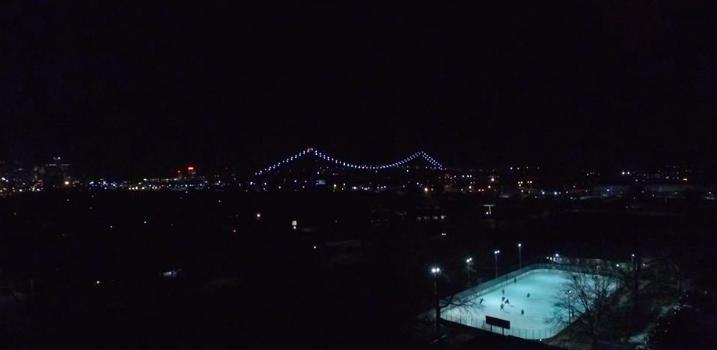
Like most hockey stories, it starts with a game of shinny – drop-in, as it’s known at Clark Park. There are about 15 of us at the rink on this occasion, Monday night of President’s Day weekend, and we can see our breath and only barely feel our toes. We skate for a couple hours, one goalie switching between both nets, and we don’t keep score. Better yet, we lose track. There are stretch passes and odd-man rushes and shots from all over. There is very little back-checking. The air is still tonight, but flatly cold, and it fills our lungs with a chill. It reddens our cheeks and makes our noses run. Icicles of snot hang from our face masks. (Well, mine anyway.) The whole world seems to exist right here for the moment, like time might be standing still, like the moon won’t fade until our legs give out.
It’s about 10:00 when we eventually start trickling toward the locker room, and the work week looms. Reality. Imagine that.
I’m sitting at my desk the next day, legs a bit sore, when I get a text from a new friend. He’s listed in my phone as ‘Brent Hockey.’ His real name is Brent Benavides, and his dad, Anthony, is the director of Clark Park. Anthony was born and raised in Southwest Detroit. Clark Park is where he learned to play hockey; it’s very much where he grew up. Now he runs the place, which in the winter means running the rink. When there’s open ice, Anthony sends word to Brent who gathers a group for some drop-in, $10 a head. On this day, though, Brent’s just looking for an extra player.
“What’s up,” he asks. “There’s a tournament this week at Clark Park. Wednesday – Saturday. Would you possibly want to play? There’ll be a few skaters from last night playing in it.”
Would I possibly want to play? Are you serious?? Dude, tell me where to sign!
I play it cool and text him back, “Absolutely.” He tells me our first game is at 6:00 Wednesday night. I add in something like, “Hell yeah.” I can’t help myself.
***
In Southwest Detroit, Clark Park is a staple. It stretches from I-75 to Vernon between Clark Ave and Scotten, smack dab in the middle of Mexicantown, and includes soccer fields, ballfields and tennis courts. The first sign of ice skaters can be found in a photograph from 1888; they laced them up back then on a pair of kidney-shaped ponds that froze every winter. The city eventually put up a small rink in the early 1940’s, right next to a log cabin whose wood furnace made for a nice warming hut. This is where Anthony Benavides, and so many others, learned to skate.
Ziggy Gonzalez, 87, was one of the first. The son of Mexican immigrants, Ziggy didn’t stumble upon a hockey game until he was 13 years old. His reward for serving as a safety patrol boy at his elementary school was a trip to the Olympia to see the Red Wings plays the Rangers in 1944. “It was love at first sight,” he recalls. “I saw the game and thought, ‘Wow. We gotta play this.’” Three years later he finally had enough money to buy a used pair of skates from the Salvation Army. Then he rounded up a group of his friends, took to the ice at Clark Park and fell in love all over again. He's still in love some 70 years later. "I never got hooked on a sport as deeply as I did with hockey," he says.
Over time, outdoor ice rinks began popping up at rec centers across Detroit. The original one at Clark Park would be knocked down and replaced in 1974. Ziggy still remembers Mayor Coleman Young cutting the ribbon; he must have been a busy man. There were rinks on the east side at Farwell and Heilmann, one on the west side at Butzel, and others off the Lodge at Wigle and off 94 at O’Shea. There were eight of them at the height of it all, and teams from each neighborhood comprising an ethnically diverse rec league – the Hungarians from Delray, the Polish from Claytown, the Maltese from Corktown. Mexicantown had a team of its own. It was Ziggy who started it, of course. “We skated all over the city,” he says.
But Detroit met its inevitable fate. Factories closed and the population shrunk. Tax money dwindled and park budgets dried up. The rinks went mostly unused. One by one, they were bulldozed, wiped off the map like they never existed. Clark Park is the lone survivor and, today, the only regulation-sized outdoor hockey rink in Detroit.
The 61-year-old Benavides is a big reason it’s still around. He’s wearing a CCM ‘Clark Park Hockey’ cap when we first meet. He has a gray mustache, fatherly eyes and the ruddy complexion of a man who has spent much of his life outside. His passion for the park, and in particular its hockey rink, rings gently through his voice when the subject comes up. He chooses his words thoughtfully, but they don’t seem hard for him to find.
“It means a lot to have people experience the game (of hockey) outdoors, kids and adults, and continue to play outdoors. I think it’s important,” Benavides says. “Indoors is fine, but you’re just locked in there with a roof over your head. But the outdoors, to play out in the snow and amongst the trees and in the open environment, that’s special.”
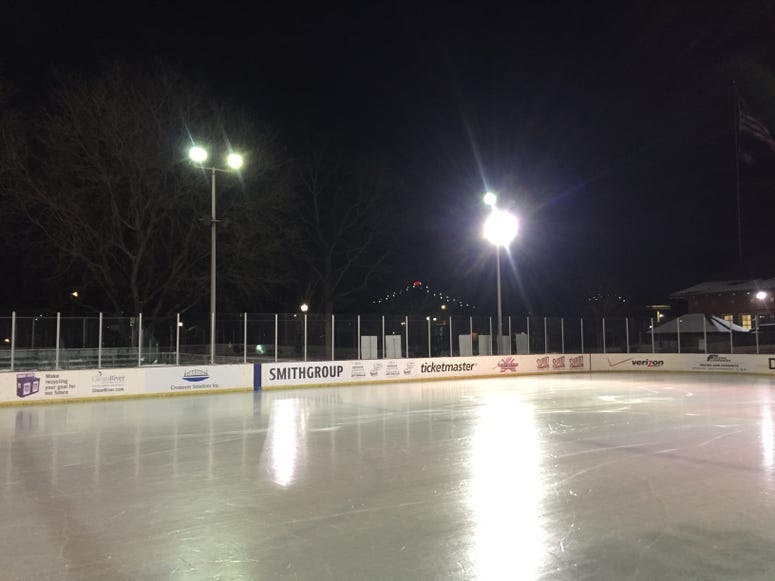
***
I dip out of the office a bit early on Wednesday, unable to sit still any longer. It’s 5:00 and we take the ice in an hour. I swing by my house to grab my gear, and feel compelled to re-tape my sticks – that restless habit that precedes any big game. From where I live in Royal Oak, it’s pretty much 75-South the whole way. I drive past Comerica Park, solemnly waiting out winter, and past Little Caesars Arena, which is awash in red light this evening for the Red Wings game. I drive past Motor City Casino, and then – poof – the Ambassador Bridge appears in the night sky like a constellation I can touch. I’m still admiring it in my rearview when I nearly miss the exit for Clark Ave.
I catch the glow of the park the moment I veer off the highway. It’s a gloomy evening, a few degrees above freezing with a steady drizzle, and the lights above the rink beckon in the haze. The parking lot isn’t quite full, but it’s the busiest I’ve seen it, and there’s a white tent set up just outside the brick building that houses a pair of locker rooms. I make my way through for registration. “Will Burchfield,” I tell the young woman behind the table, as she begins flipping through rosters. “I think I was just added today.” We find my name, and my tournament has officially begun. “Wait,” I say. “Do you know who I’m playing for?”
“Clark Park,” she tells me – and I think that’s pretty damn cool.
Our roster is comprised mostly of coaches in the park’s youth hockey program, plus a few alumni of the program and then a couple mercenaries like me. We range in age from our mid-20’s to our late 30’s. We are white, black and Mexican. We’re pitted in the first game of the tournament against the Sparkplugs, the two-time defending champs from Downriver. Our team has some good skaters; these guys are flat-out better. Their best player wears No. 71, rocks a half-shield and sports a goatee a la Dylan Larkin. Their jerseys make them look the Red Wings. A 1-1 game in the first quickly devolves into a 9-2 rout, and the scoreboard does us a favor by not going past single digits. By the third period, No. 71 is making passes between his legs, just for show. I begin to chirp him from the bench, then remember we’re down by seven.
In the locker room afterward, player-coach Brian Merlos tells us we all skated hard. He reminds us tomorrow night’s game is at 9:00. Then he announces our goalie, who stood tall despite the score, will return to his usual position on defense for the rest of the tournament, while our goalie’s girlfriend will be stepping into the crease. Maybe this is the shake-up we need.
***
Less than a mile from Clark Park, just a few blocks down Clark Ave, is the headquarters of a company called Ideal Group. It doubles as a community advocate in Southwest Detroit, having been located there since 1995. Over the years, Ideal Group has worked closely with Clark Park in ways big and small, from fundraising and sponsoring events to lending a hand in clean-up projects. The company understands that a neighborhood with no park is hardly a neighborhood at all.
The VP of Ideal Group is an avid hockey player by the name of Jesse Venegas. He’s 37 years old, and not all that keen on growing up. (Amen, brother.) A thick black beard is his only admission of age. He’s short in stature but long on ambition, and he’s got a deep, hearty laugh that might be up to something. He’s an idea man. (He’s also a goalie, so you know he’s a little nutty.) Five years ago, Venegas, who grew up in Brighton but whose family is from Detroit, was thinking of ways to stir up more action at the Clark Park rink and maybe raise a little money for its youth hockey program. A tournament, he decided, where each team pays an entry fee and all proceeds go to the park. Ideal Group would sponsor it.
“My goal was just to get a couple people out here and get them excited about the rink. Play some hockey, have some fun and then if we can do something good at the end of the day by helping the kids with a sport I absolutely love…” Venegas pauses. “I want more kids to play hockey, and it’s not an easy sport for kids that don’t have the means to play because it’s so expensive. It’s done a whole lot for my life. For these kids, I wouldn’t want them to not have the opportunity to play hockey.”
And so the Clark Street Classic was born. There were six teams the first year. The tournament ran from Friday to Saturday in some of the harshest weather of the winter: fierce winds, heavy snow and sub-zero temperatures. The players took shelter in the locker rooms between games. The American flag above the building was frozen stiff. When the snow began to pile up, everybody grabbed shovels and cleared the ice. The wind was so severe that one game was effectively decided when the two teams switched ends in overtime. (Ever try skating into a headwind?) The Clark Park team, no stranger to the elements, claimed the championship. And Venegeas’ efforts raised $5,000.
He deflects the credit when I ask him about it, as we stand along the boards behind one of the goals and watch his creation shine. “When it comes to all these guys wanting to contribute a couple bucks for the kids, they don’t mess around,” he says. “They’re just like, ‘Let’s just do it, whatever we gotta do.’ These guys are the greatest people out here.” A two-on-one rush comes our way and the puck-handler rips one past the goalie. “Ohhhh, nice goal, Pitters! He sucks, I hate Pitters. He’s got a great f**cking shot. He’s a good player, but he pisses me off because he’s good.” Venegas laughs and continues. “It’s just all about these people. They’re the ones that make it happen.
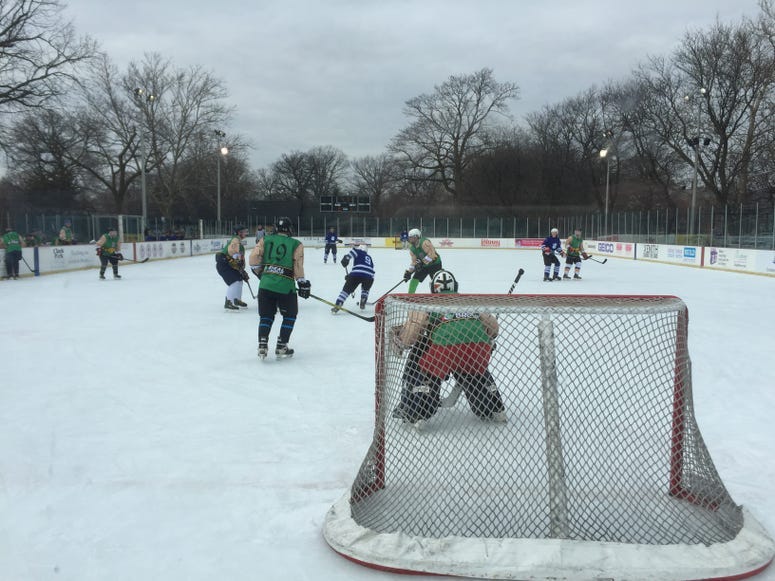
***
The parking lot is full when I pull in around 8:00 Thursday night. Rock music is playing on the speakers outside the locker rooms, flames are leaping from two standing fire pits nearby and happy people are enjoying each other’s company. There’s a group of players suited up and ready to take the ice, and another group that just came off – it’s impossible to tell who may have lost. There are spectators in the crowd, too, friends of players just here for a good time. Labatt Blue is the beverage of choice. It’s a down-home neighborhood gathering, a winter carnival without all the attractions and props. There is hockey and there is beer, and there are people who enjoy both.
We take the ice a little after 9:00, playing a team from Garden City that won easily the night prior. We score first, but find ourselves down 4-3 in the third. Inside three minutes remaining, our original goalie, the one now playing defense, weaves his way through several players and scores a beauty to knot things at 4. Nice call, Coach! That’s where it ends, a tie that feels a bit like a win.
Because there are 12 teams this year – a Clark Street Classic high – Venegas has divided them into three divisions. We’re playing in the Ziggy Gonzalez division. And who walks into the locker room after our game but Ziggy himself, smiling from ear to ear. He’s wearing a Clark Park Hockey sweatshirt beneath a leather jacket, and the eyes behind his glasses twinkle with stories. He still skates now and then; hockey has never let go of his heart. Ziggy is glowing tonight because the park is buzzing, the way it so often was when he was younger, and because there are faces here he's never seen. I think he knows he'll see them again. I’m one of the first to shake his hand, and he tells me the pleasure is his. He’s wrong.
I ask him later what it means to have a division named in his honor. “It was a big feather in my cap. I really loved it,” he says, a touch of mischief in his voice. “When I got home, my head was so big my wife wanted to buy me a new hat!”
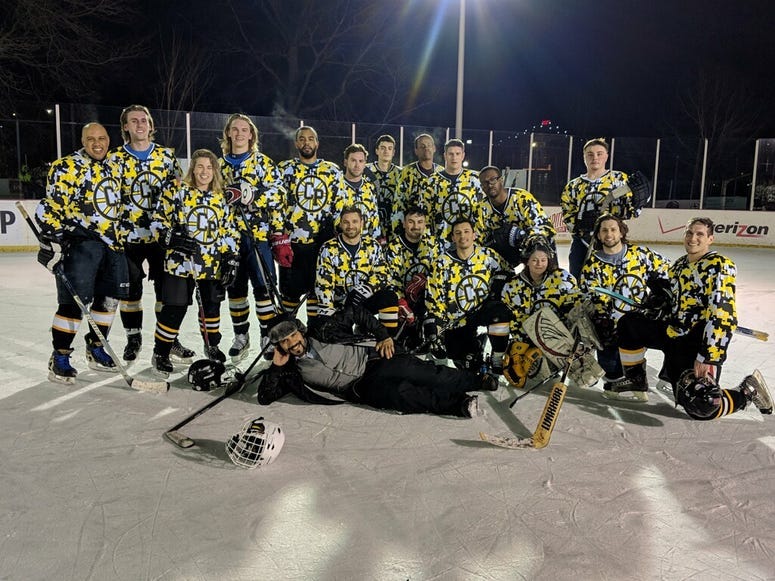
***
When Detroit’s outdoor rinks were being torn down, the parks around them were being closed, too. Budget cuts left the city with no choice. But when it came to Clark Park, which had deteriorated into a scene of crime and was on the verge of being shut down in the early ’90s, a group of advocates in Southwest Detroit pushed back. They formed the Clark Park Coalition, and convinced the city the park could be saved. Anthony Benavides was a founding member. So was Deb Sumner, who, in Ziggy’s mind, deserves the bulk of the credit for the coalition’s success.
“When everyone else was afraid of the city, she went and confronted them. And they backed off. She said, ‘You’re not going to close this park down. What are you going to do, build a wall around it?’ Walls weren’t in vogue in those days like they are now with Trump,” Ziggy cracks. “She said, ‘Go ahead. Close this rink. Let’s see how you’re going to do it.’”
Truth be told, the rink was in terrible shape. The boards were collapsing, where they weren’t missing sections. The compressors were down. The condensers were, too. Benavides knew something had to be done quickly, so he secured some donations, including $15,000 from former Tigers pitcher Hank Aguirre, who owned a manufacturing business in Southwest Detroit, and gathered a group of volunteers to start piecing the rink back together. The volunteers repaired the boards by hand, which back then were made of wood. Then the city hopped onboard and helped replace the expensive machinery. “That gave us a shot in the arm,” says Benavides. The rink was operational again by the mid ‘90s.
About 10 years later, it was in need of more help. Enter Dewey Henry, a Wayne County official who had spent much of his childhood at Clark Park. “Dewey came on the scene and said, ‘We’re going to rebuild this rink from scratch,’” says Benavides. When the park held a non-profit event for which Henry and then-Wayne County executive Ed McNamara were present, Henry made a poignant pitch to the man in charge. He pointed across the street to his old house. He pointed in the same direction to his old school. He pointed to the tree where he kissed a girl for the first time. (He probably had several trees to choose from.) “This was my park,” he told McNamara.
“Dewey put Ed on the spot,” recalls Benavides. He said, ‘Hey, Ed’ – Big Shot Ed – ‘what are you going to do about Clark Park? We need to make an investment. And Ed said, ‘What do you think we need? How much?’”
In 2004, Clark Park received $1 million from Wayne County. The rink was remodeled to last, with modern-day plastic boards replacing those wood ones and Plexiglas instead of chain-link fencing. There have been more upgrades since – “It’s a never-ending restoration process,” says Benavides – but this is essentially the rink that stands today.
***
Thursday night’s tie was nice, but we need a win. We’re the host team, dammit. At the very least, I need a win, considering I’m the newcomer on a team that has won this tournament in the past. Trying to channel the right mindset, I show up to the rink a couple hours before our game against the Oakland Turbos. We won’t start playing until sometime around 11:00.
One of the first teammates I find is a fellow mercenary named Eric. He tells me he’s got beer in his bag, and I act responsible and tell him we’ll crack a few after. “After?” he asks, as if I’m speaking a foreign language. “You’re right,” I tell him. “We’ll crack a few right now.” Eric and I find a place to stand along the boards behind the net, and start chatting with a couple guys next to us from another team. One of them asks how we’ve fared so far. I shake my head and tell him not so well – but hey, we had a tough draw playing the three-time defending champs in the first game.
“Two-time defending champs!” he corrects me. “We beat them the first time.”
If there’s a defining rivalry of the Clark Street Classic, it’s the Sparkplugs vs. H.H. Barnum. They've squared off in the finals three years in a row, with each game being decided in overtime. Barnum, one of the Clark Street Classic’s original six, is here to level the score. But these guys have other things on their minds, too, like the bars and casinos later that night and the fact that it’s National Margarita Day and here we are in the middle of Mexicantown. They celebrated the occasion earlier, which isn't to say they won't celebrate again.
We can’t catch a break against the Turbos. We lose 5-1, bringing our record to 0-2-1 in round robin play and setting up a quarterfinal matchup on Saturday with a juggernaut from the Detroit Athletic Club. They’re playing against Barnum in Friday’s nightcap, so I stick around for a bit to see what we’re in for. I quickly realize we’re in for a lot. But what is Clark Park if not resilient? The people here have defied the odds before.
It’s close to 1:00 in the morning as I start walking toward my car, and there’s still a hockey game being played in Southwest Detroit, five a side with full benches, beneath the lights and the moon and the nearby gleam of the Ambassador Bridge. Time seems to pause again. Things are quiet but for skates slashing the ice, sticks smacking the puck back and forth and the occasional whistle of a referee, which halts this old record, just for a moment, until a new group of players spills over the boards and it continues to spin.
"Debbie (Sumner) brought up a good point,” Ziggy tells me. “She said, ‘Ziggy, where else can you skate and look up at the sky and see the stars?’ I said, ‘Only if some big defenseman like Scott Stevens racks you up. You can see stars that way!’ She said, ‘You’re crazy.’ I said, ‘That’s why people love me.”
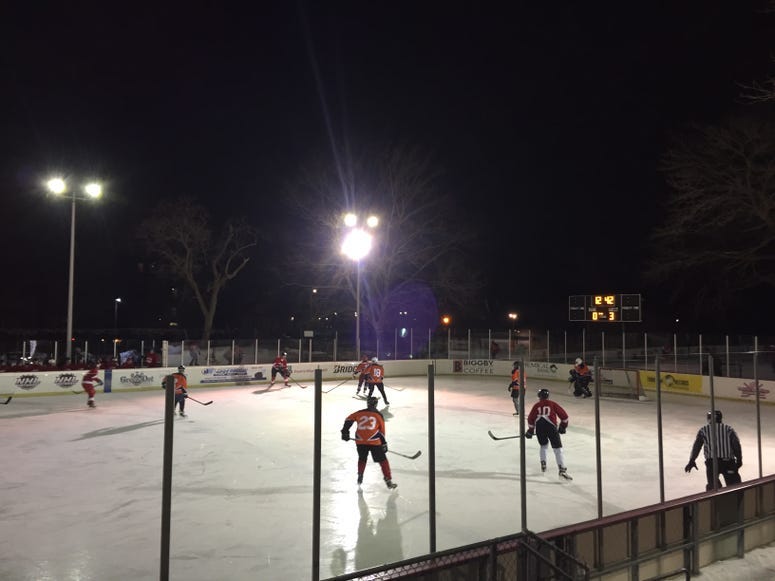
***
Family is the word most often used to describe the feeling at Clark Park, among those who know the place best. This intimacy seems closest around the rink. There is a collective commitment to look after the place, and with that comes a sense of esprit de corps. In last year’s tournament, Clark Park ended up brawling with Garden City because the visitors were apparently playing dirty. It was an ugly scene, and the players from Clark Park aren’t proud of it. But they weren’t going to be bullied, not on their own ice. “It speaks to the passion around here,” says Merlos, our player-coach. “People are putting their hearts into this place. We’re going to stand up for it.” Afterward, both teams shook hands.
Jamie Plascencia – like Ziggy, the son of Mexican immigrants – has played for the Clark Park team each year of the tournament. At 37, he’s one of our vets. In fact, he’s skated at Clark Park every year since it introduced him to the game of hockey around the age of 10. “What is this?” he remembers thinking at the time. Now his nine-year-old daughter skates here. Plascencia, who met his wife at the park during a softball game, lives with his family three blocks away. He smiles and confirms there’s lots of hockey in his future.
Rene Montemayor, for his part, is done. He still loves the game, but his knees can’t take it anymore. These days he’s content to watch. He was 13 when he learned to skate at Clark Park, and he busted his lip in half the first day. (“Anthony got me a Band-Aid,” he chuckles. “It needed more than that.) He spent so much time here over the next year that he wanted to know how he could help out. Within time he was driving the Zamboni. His school work permit allowed him to get paid.
But Montemayor, also the son of Mexican immigrants, couldn’t find a steady job in Detroit after high school, so he packed up and moved to Texas to manage cattle on his uncle’s ranch. The cowboy life was dangerously fun. The pay was good. “But it didn’t feel natural. I missed the winter, the ice. I missed the park,” says Montemayor. "I missed the people." He mentions Ziggy and Benavides, among others. Now 26, Montemayor is maybe the only regular at the park who isn’t younger than he looks. He has long black hair that he sometimes wears in a ponytail, a scraggly beard that covers his weathered face and a slight hitch in his gait from a cattle-herding accident in his early 20’s. He also has a deep appreciation for life and a heart that led him home.
“It was just family here,” says Montemayor, who returned a couple years ago and now works at the park on weekends. “It’s a good feeling when they welcome you back with open arms.”
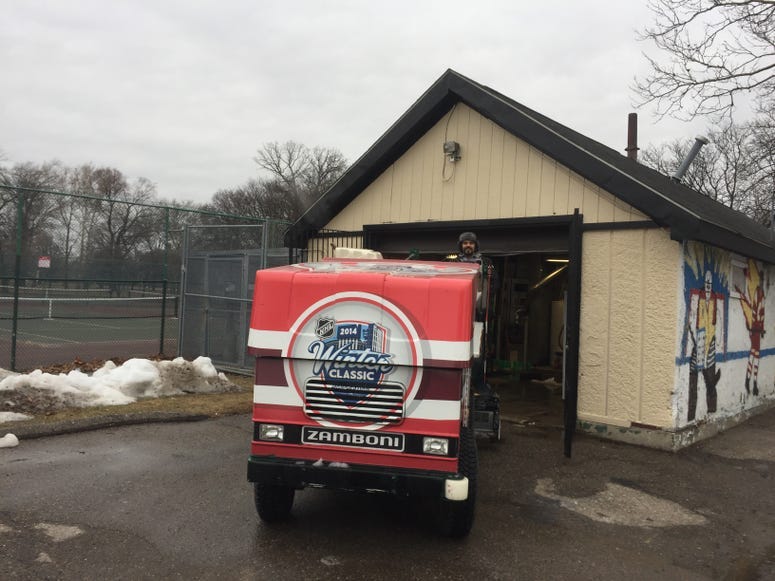
Merlos, 29, moved to Southwest Detroit a few years back and wound up neighbors with Benavides. He played some men’s league hockey in the area, but had no idea there was an outdoor rink basically around the corner from his house. When he was carrying his equipment bag inside one night, Benavides saw him and said, “You’re a coach now. See you Tuesday.” Merlos has been there just about every Tuesday since. He serves as both the hockey manager, scheduling ice time for the entire youth program (ever at the weather’s mercy), and a coach for the 8U and Learn to Skate teams. Like all coaches at Clark Park, Merlos is a volunteer. If it was happenstance that brought him here, it’s something much more profound that keeps bringing him back.
“People have worked so hard to keep this program alive. It’s in my hands now,” he says. “There’s a responsibility to not just sustain it, but grow it.”
***
It’s Saturday morning; our day of reckoning has arrived. A loss to the Detroit Athletic Club and we’re finished. I have zero goals through three games, so I pick up a case of Labatt on my way down to the rink. At least I can contribute something. I arrive around noon for a 2:00 game, and Eric, my fellow mercenary, is already here. So are most of our teammates. The skies are grey, and the lights are on above us with rain in the forecast. It’s a few degrees above freezing. I tell Eric I’m visualizing our upset as I hand him a beer, and remind him that the 1980 Miracle on Ice was 39 years ago yesterday.
Venegas and Montemayor, meanwhile, have been here since 9:00 this morning. They left around 2 a.m. last night – Venegas, in particular, does far more work this weekend than he lets on. At the moment, he’s in net for his team from Ideal Group and under siege in a 7-2 loss to Garden City. The man’s been pelted with more rubber the past few days than anyone, but I suspect he enjoys it. When he emerges from the locker room a short while later, he’s carrying a bottle of whiskey from the Motor City Gas Distillery in his coat pocket, daring anyone bold enough to take a swig. When I take him up on it, gas is about what it tastes like.
We skate hard against DAC, harder than they seem to skate. It doesn’t matter. They’re working three-man weaves and circling our net like the 1980 Soviets, and we don’t have Mike Eruzione to even the scales. 2-0 after the first becomes 4-0 after the second, which ends in a 7-0 final. We can do nothing but tip our hats (and maybe seek out the tough guy that ran one of our players for no reason. (DM’s open, tips welcome.)) They were better.
We turn in our jerseys and socks after the game, and I wish I could have done the uniform prouder. Turns out that’s a better job for the kids. They’re up after us, racing onto the ice for the Clark Street Classic’s Saturday afternoon youth showcase. This year it’s the 12U boys taking on a squad from Novi, and it’s the best game of the afternoon. Clark Park goes up 4-1, before Novi storms back in the third for a 4-4 tie. The home team has a couple real players. One day, this tournament will be theirs.
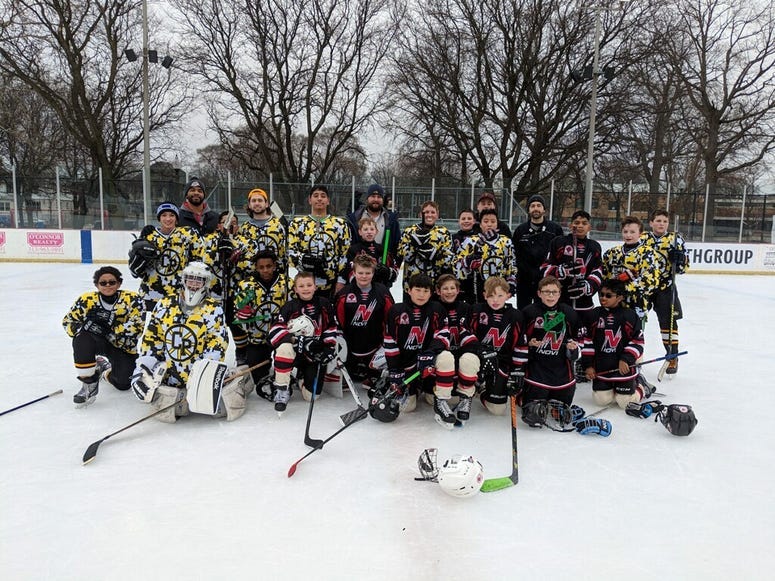
***
There may not be a more expensive youth sport in this country than ice hockey. The gear alone is pricey, and that’s before the much larger cost of joining a team. A recent study by Time Magazine revealed that an average hockey family spends about $7,000 per year. At Clark Park, aside from USA Hockey’s $40 annual registration fee, the youth hockey program is free. The gear, the ice time, the coaching – all of it, free. Every year, this allows countless kids to play a sport that would otherwise be out of their reach. In many cases, these kids are black or Mexican-American, distinct minorities in the sport of hockey.
The program is growing. Last year, according to Merlos, there were about 50 kids registered. This year, just over 100. And it’s growing at the right level, with most of the recent enrollees in in the four- to six-year-old age group. The teams, most of which are co-ed, practice five days a week and typically play about eight games per year. The schedule is thin because the program is comprised primarily of house teams that aren’t credentialed by the Michigan Amateur Hockey Association. “That’s something we’re working on for next year or the year after,” Merlos says. They’re also hoping to extend the season, says Benavides, by adding a spring team that would play indoors. The ice at Clark Park typically doesn’t last much longer than three months. “It’s hard,” says Benavides. “Once those sun rays come out in April...”
Benavides missed most of this year’s Clark Street Classic. He was in Philadelphia for a meeting of 20 youth hockey programs in the NHL’s Hockey is For Everyone initiative. Kids from each program took part in the Willie O’Ree Skills Weekend ahead of the outdoor game between the Flyers and Penguins, while coaches and directors like Benavides discussed how to fund and grow hockey in inner cities. Benavides came across maybe one other program whose kids play for free. “I think we’re the lowest cost anywhere in the U.S.,” he says. Fund-raising and donations make it all possible.
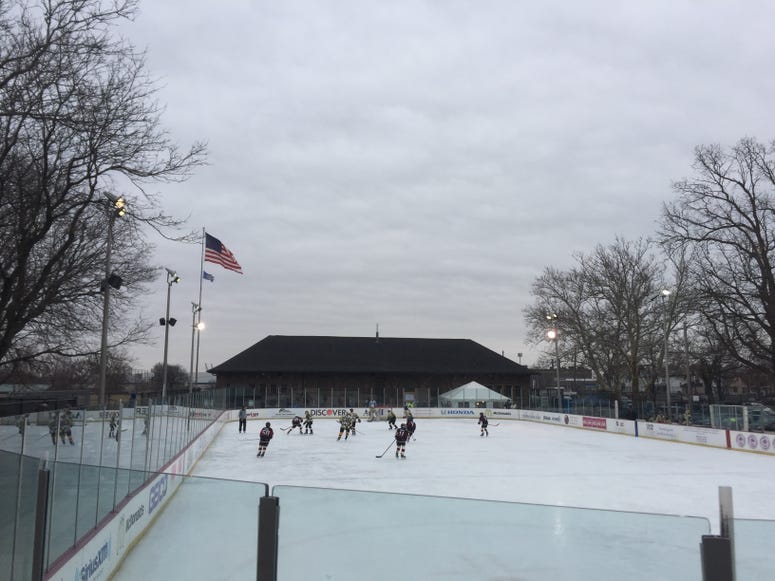
***
“You want to come for a ride?” Montemayor asks me after the youth game is over. One of two longtime Zamboni drivers at Clark Park – and the superior one, he’ll let you know with a wink – Montemayor is about to clean the ice for the next game. I can’t hop on quickly enough; before I fell in love with hockey, I was head over heels for that big machine that came out between periods. The Zamboni at Clark Park isn’t the one Montemayor learned to drive when he was 14 years old. In 2013, the NHL and the Detroit Red Wings Foundation, the latter an affiliate of Ilitch Charities, donated about $200,000 worth of upgrades to the park. The centerpiece was a sparkling new Zamboni. Montemayor regales me on the machine’s composition, down to every last lever, then breaks down his process like an artist as we circle the rink. “The best Zamboni driver in Detroit!” I tell him. “I wish,” he smiles. “That’s Al Sobotka.”
The crowd grows as the afternoon turns to evening and the stakes continue to rise. The rain arrives in the form of a cold drizzle, but the fire pits are crackling and there’s plenty of beer to go around. Venegas starts to get more takers on his whiskey. There are 40 or 50 people on hand, and I’m not sure any of them would prefer to be anywhere else. “This is it,” says one onlooker standing next to me by the fire. No argument here. In the semis, Barnum takes care of Garden City, and DAC dispatches the Sparkplugs, the two-time defending champs. Alas, the rivalry will not be renewed.
Probably more than any team in the field, DAC is here to win this thing. They fell short last year, so they returned with two teams and formed an All-Star squad with their best players. They’ve got several guys who played in college, not to mention three coaches who wear matching varsity jackets behind the bench. Barnum has some elite players themselves, including a couple guys who made it as far as the ECHL, but they don’t seem quite as gung-ho on winning. Their routine between games, their coach tells me, is to hunker down at a local bar. “DAC is probably drinking water and eating kale,” he grins.
For Venegas, this is the realization of a vision. He wanted the Clark Street Classic to be “as competitive as possible” when he conceived of it. While the general skill level is still pretty wide, the top talent is no joke, and it’s all veering toward that end of the spectrum. “The hockey just keeps getting better and better,” Venegas tells me a couple days after the tournament. “I was thinking today, ‘You know what, that was kind of like the outdoor adult amateur championship of the city of Detroit.’ We had good-enough teams where we could say, ‘Hey, these are the best adult teams in Detroit.’ Originally it was just guys getting together and having some fun being downtown, but the hockey’s just gotten so good over the last few years.”
The puck drops on the championship, and DAC races out to a 3-0 lead. But these Barnum players have been here before. They cut the deficit to 3-2 in the third period, and we’ve got ourselves a game. It’s all Barnum as the clock winds down. The vets have the newcomers on their heels. But the constant pressure eventually leads to a rush the other way for DAC, and the team that came here to win puts the game on ice. It’s a 4-2 final. DAC claims the trophy it deserves. They make plans to celebrate downtown, and players from both teams start trickling toward the parking lot around 10 p.m. It’s really starting to rain now, so I take cover in my car. Venegas, Montemayor and a couple others are still breaking things down. I watch them cut the lights a little after 11, honk my horn and head for home.
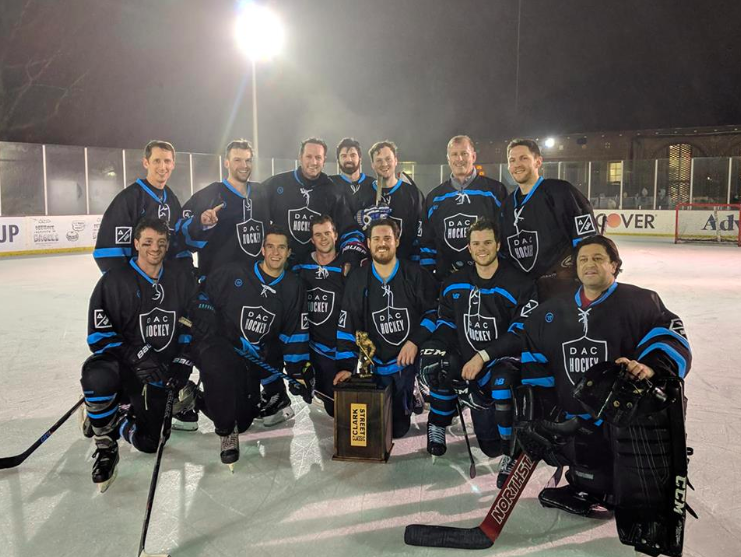
***
One of three main winter fundraisers for Clark Park, the tournament is an undoubted success. Venegas acknowledges it’s not cheap to enter – a cost of $1,800 per team – but that’s kind of the point considering the cause. This year it raises over $15,000, $14,000 of which will be split between the Clark Park youth hockey program and repairs for the rink. (The rest will go to the Clark Park Coalition’s general budget.) Among other things, Benavides says the money will help fund the spring league he’s hoping to get off the ground. “Some of these kids are here every day,” Benavides says. “I’m glad we can offer them hockey throughout the winter, and Jesse is a big part of it.” And Venegas has bigger plans for next year, like maybe a big hospitality tent where people can buy food and beer. He’s looking for a company to sponsor it. Labatt Blue would be a fine choice.
“Some people want to keep (the rink) our secret, and in some ways it still kind of is our secret where we can go play. But we have so many cool things in Detroit that have been forgotten and that made the city so great, that it’s fun to get other people to discover them,” Venegas says. “I mean, Clark Park is an absolute gem in this city. And it's not just the rink. It's the people, and everything they do."
I’ll be back, so long as the Clark Park team wants me. I imagine most everyone that experienced it will return, too. There’s an outdoor rink in Southwest Detroit, hockey in the middle of Mexicantown, the vestige of a bygone era that doesn’t feel so distant when you take the ice.
